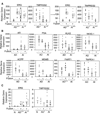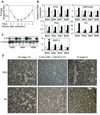Reactivation of androgen receptor-regulated TMPRSS2:ERG gene expression in castration-resistant prostate cancer
- PMID: 19584279
- PMCID: PMC2859723
- DOI: 10.1158/0008-5472.CAN-09-0395
Reactivation of androgen receptor-regulated TMPRSS2:ERG gene expression in castration-resistant prostate cancer
Abstract
It seems clear that androgen receptor (AR)-regulated expression of the TMPRSS2:ERG fusion gene plays an early role in prostate cancer (PC) development or progression, but the extent to which TMPRSS2:ERG is down-regulated in response to androgen deprivation therapy (ADT) and whether AR reactivates TMPRSS2:ERG expression in castration-resistant PC (CRPC) have not been determined. We show that ERG message levels in TMPRSS2:ERG fusion-positive CRPC are comparable with the levels in fusion gene-positive primary PC, consistent with the conclusion that the TMPRSS2:ERG expression is reactivated by AR in CRPC. To further assess whether TMPRSS2:ERG expression is initially down-regulated in response to ADT, we examined VCaP cells, which express the TMPRSS2:ERG fusion gene, and xenografts. ERG message and protein rapidly declined in response to removal of androgen in vitro and castration in vivo. Moreover, as observed in the clinical samples, ERG expression was fully restored in the VCaP xenografts that relapsed after castration, coincident with AR reactivation. AR reactivation in the relapsed xenografts was also associated with marked increases in mRNA encoding AR and androgen synthetic enzymes. These results show that expression of TMPRSS2:ERG, similarly to other AR-regulated genes, is restored in CRPC and may contribute to tumor progression.
Figures




References
-
- Tomlins SA, Rhodes DR, Perner S, et al. Recurrent fusion of TMPRSS2 and ETS transcription factor genes in prostate cancer. Science. 2005;310:644–648. - PubMed
-
- Wang J, Cai Y, Ren C, Ittmann M. Expression of Variant TMPRSS2/ERG Fusion Messenger RNAs Is Associated with Aggressive Prostate Cancer. Cancer Res. 2006;66:8347–8351. - PubMed
-
- Perner S, Demichelis F, Beroukhim R, et al. TMPRSS2:ERG Fusion-Associated Deletions Provide Insight into the Heterogeneity of Prostate Cancer. Cancer Res. 2006;66:8337–8341. - PubMed
-
- Tomlins SA, Laxman B, Dhanasekaran SM, et al. Distinct classes of chromosomal rearrangements create oncogenic ETS gene fusions in prostate cancer. Nature. 2007;448:595–599. - PubMed
Publication types
MeSH terms
Substances
Grants and funding
LinkOut - more resources
Full Text Sources
Medical
Research Materials

